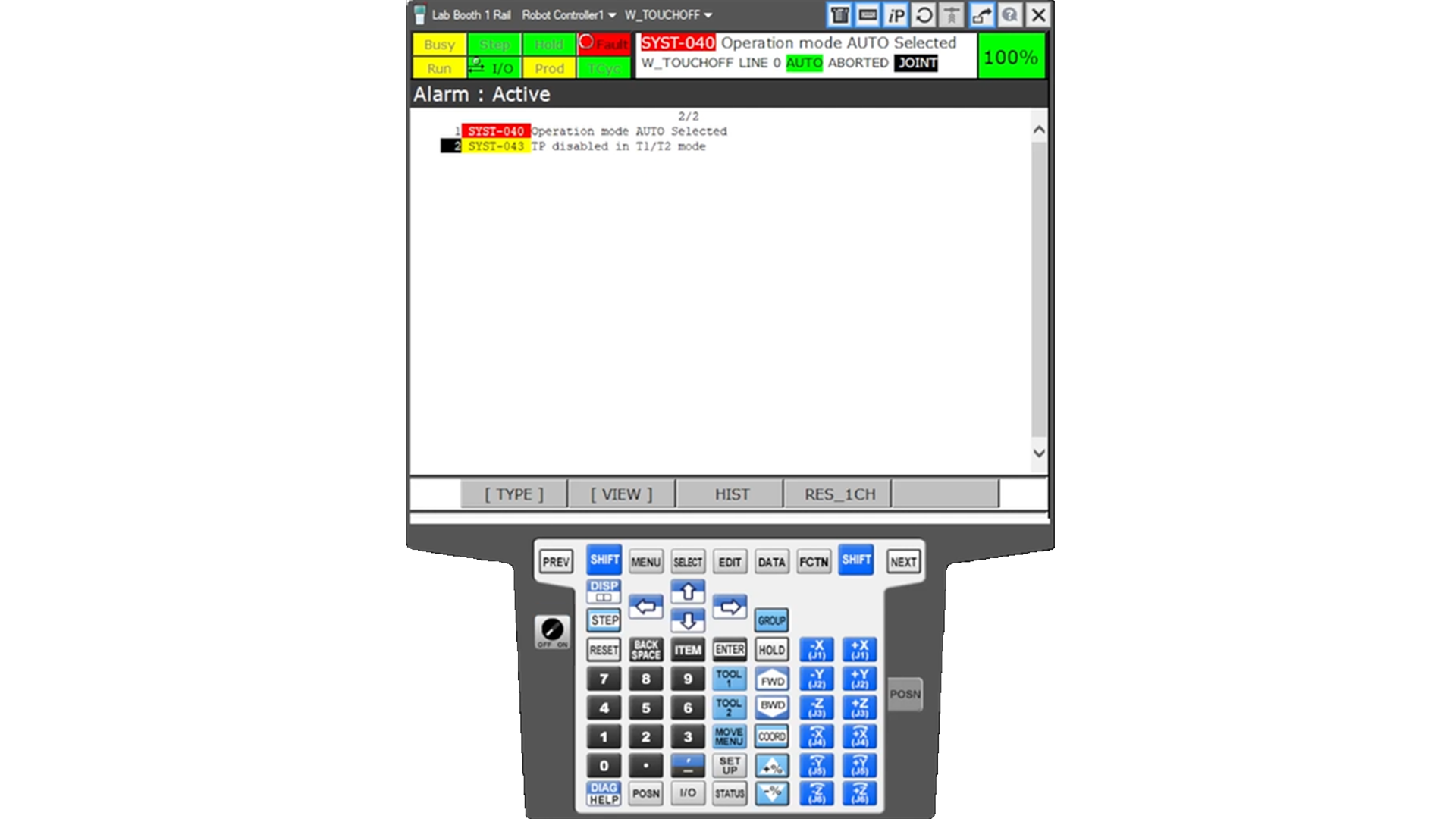Emergency Support
For emergency robot support,
call us at (256) 319-1170.
Common Problems
Complete the following as needed:
- Check your HMI to ensure that dry run is disabled. Instructions on doing so should be available in your operations manual.
- Make sure to inspect the fluid lines for any clogs or damages.
- Check to ensure you have material inside your pots.
If all else fails, contact us!
Complete the following as needed:
- Verify you are using the correct nozzle.
- Clean the nozzle and verify it is not clogged.
- Check the air cap for proper alignment.
- Run a plume test or witness panel program to ensure any changes have fixed the issue.
If all else fails, contact us!
A FANUC BZAL alarm generally can mean one of two things:
- Your robot controller batteries are dead. Please refer to your FANUC documentation or watch this video.
- Your cables could be loose. Make sure they are plugged into the motors.
If all else fails, contact us!
NOTE: Do not power off the controller when changing batteries as this will cause the robot to need to be remastered.
Complete the following as needed:
- Verify that the pressure regulator settings have not been modified.
- Check that there is an adequate air supply and that no lines have been knocked loose or have damage.
- Repeat the purge process on your robot controller.
If all else fails, contact us!
It’s an easy step to overlook but make sure your booth is on. If so, check your HMI to ensure the booth is within appropriate temperature and humidity settings.
This error can have several associated codes and fixes. Please see below:
- INTP-105
This means that the run request has failed and the program cannot start. - INTP-248
This means the MACRO command has failed or cannot execute. - INTP-250
This means the uFrame is invalid. - INTP-251
This means the uTool is invalid. - INTP-252
This means the uFrame is mismatched. - INTP-253
This means the uTool is mismatched. - INTP-447
This means the parenthesis are mismatched.
If you experience any issues with INTP-250, 251, 252, 253, or 447, contact us!
The most common jog errors and fixes are listed below:
- JOG-007
This means that the SHIFT key has not been pressed when a robot movement key was pressed. - JOG-010
This means that the SHIFT key was pressed after a robot movement key was pressed.
The most common MACR (macro) alarms are listed below:
- MACR-013
The MACRO cannot execute. - MACR-016
The MACRO execution has been interrupted or is incomplete.
Note: These alarms do not show unless someone has modified the robot program.
The most common MOTN errors are listed below:
- MOTN-018
The called position is unavailable or inaccessible. - MOTN-019
The called position is too close to the singularity. - MOTN-063
The robot cannot execute movement to the called position. Some aspect of the configuration may have changed.
Note: These alarms do not show unless someone has modified the robot program.
The most common servo errors and fixes are listed here:
- SRVO-003/234
Seeing either of these errors means that the deadman switch was released while the robot is in motion. Reengage the deadman switch and hit the reset button. - SRVO-062/084 BZAL alarm
Seeing either of these errors means that the encoder batteries are low or the encoder cable is disconnected. To fix this alarm, check teh group and axis number listed in the alarm code (formatted like G#A#) and examine the cables in that area. Please refer to your FANUC documentation or watch our video on replacing encoder batteries for more information. - SRVO-080 OVC
This error means that the allowed RMS current has been exceeded. Restart the robot system. If you continue to have this alarm, your payload may be set wrong. Call us! - SRVO-160
This error means that an emergency stop button has been pressed. Please reset emergency stops manually or at the HMI, depending on what your system allows. In most cases, you must additionally reset the alarms on the alarms screen at the HMI before the system can continue. - SRVO-161
This error means that the fence circuit has been broken or a deadman switch has been released. Please check that the fence circuit is properly closed and that all deadman switches are properly engaged then reset the alarm at the HMI. - SRVO-162
It means that an emergency stop is engaged or the fence circuit is broken or a deadman switch has been released. Check that the fence circuit is properly closed, that all deadman switches are properly engaged, and that all emergency stops are reset (either manually or at the HMI) then reset the alarm at the HMI. - SRVO-230/231
This alarm appears if there is a break in Channel 1 (24V) or Channel 2 (0V) of the emergency stop circuit. To fix this alarm, go to the Alarms screen on the teach pendant and click RES_1CH. - SRVO-324
Check the payload, center of gravity and inertia are set correctly.
The most common system errors and their fixes are below:
- SYST-003
This error means that the teach pendant is enabled when it should be disabled. Disable the teach pendant at the robot control then reset any alarms at the HMI. - SYST-017
This error means that STEP mode is engaged when it should not be. Change to the required mode on the teach pendant. - SYST-043
This error means that the robot controller is switched to T1 or T2. Switch to auto and reset any alarms at the HMI. - SYST-045
This error means that the robot controller is set to auto. Switch to T1 or T2 if you are trying to manually jog. Auto running from the HMI.


